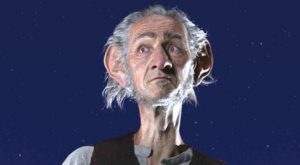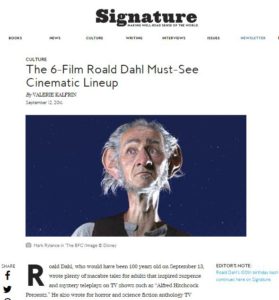
Mark Rylance in “The BFG” / © Disney
By Valerie Kalfrin
Signature Reads, Sept. 12, 2016
Roald Dahl, who would have been 100 years old on September 13, wrote plenty of macabre tales for adults that inspired suspense and mystery teleplays on TV shows such as Alfred Hitchcock Presents. He also wrote for horror and science fiction anthology TV series such as Tales of the Unexpected, and he was a screenwriter on two films based on Ian Fleming’s work: 1967’s You Only Live Twice and 1968’s Chitty Chitty Bang Bang. His inventive stories have enticed filmmakers for decades – even though the celebrated author tended to regard his film adaptations like gruesome Vermicious Knids.
The Welsh-born author, who died at age seventy-four in 1990, also remains a posthumous bookselling powerhouse. His official website says he has sold more than 200 million books worldwide. It’s no wonder libraries, bookstores, zoos, botanical gardens, and dessert companies around the country and in the UK plan to celebrate the author’s centennial.
Indeed, first and foremost, Dahl is remembered as a children’s author, with nineteen novels and poetry books for young audiences to his name. His short story collections total thirteen. Dahl’s appeal goes beyond nonsense words like whizzpopping, burp-and-fart humor, and often-sadistic and insulting adult characters, like the aunts in James and the Giant Peach who cause young James to seek food in empty chip wrappers. Rather, the six-foot-six literary giant and father of five recognized how the world can be – or seem – cruel to the weak, the small, and the unusual. Through his weird, wonderfully whimsical tales, he gave young readers courage and hope. “He was unequivocal that it is the good, young, and kind who triumph over the old, greedy and the wicked,” The Sunday Times children’s book critic Amanda Craig once said.
Dahl’s tales pack a hefty dose of mischief more than spoonsful of sugar,noted Quentin Blake, a longtime illustrator of his books. “He addresses you, a child, as somebody who knows about the world. He was a grown-up – and he was bigger than most – who is on your side.”
Dahl’s writing career began in the 1940s, when the former World War II fighter pilot worked for the British Embassy in Washington, D.C. Novelist C.S. Forester (The African Queen) suggested Dahl write about his biplane being shot down in the Libyan desert, a crash that fractured Dahl’s skull, smashed his hip, and caused two spinal injuries.The Saturday Evening Post published the tale for $1,000. His first full-length story, The Gremlins, later published under a pseudonym, attracted the attention of Walt Disney, whose film version of these creatures that caused airplane mechanical failures never got off the ground.

As seen on Signature Reads
Instead, Dahl’s first experience with his own work adapted for the screen was 1971’s Willy Wonka & the Chocolate Factory, based on his 1964 book, Charlie and the Chocolate Factory, for which he wrote the screenplay. (David Seltzer, who later wrote the screenplay for The Omen, did an uncredited rewrite.) Dahl drew inspiration for the film’s source material on his experience taste-testing chocolate as a boy. He dedicated the book to his son, Theo, and so disliked some of the changes from page to screen that he wouldn’t grant permission to film a sequel based on his 1972 book, Charlie and the Great Glass Elevator.
“He thought it placed too much emphasis on Willy Wonka [played by Gene Wilder] and not enough on Charlie,” Liz Attenborough, trustee of the Roald Dahl Museum and Story Centre in Buckinghamshire, once said. “For him, the book was about Charlie.”
Such began a tumultuous and frustrating process of seeing his works for children changed onscreen to enhance or streamline certain elements, or to soften sharper edges. “They always want to change a book’s storyline,” Felicity Dahl, his wife at the time of his death, once said. “What makes Hollywood think children want the endings changed for a film when they accept it in a book?”
With all that said, here are some of the best-known adaptations of Dahl’s work since that first foray into the chocolate factory. Even if fans don’t regard them as highly as the written versions, all capture some essence of a man whose work was pure imagination.
The BFG (2016)
Director Steven Spielberg’s version of Dahl’s Big Friendly Giant – so named because he doesn’t eat children – is actually the second adaptation of the 1982 book after a 1989 animated TV version from director Brian Cosgrove. Dahl created the character, who bottles dreams for children to enjoy while asleep, while married to actress Patricia Neal. He would climb up a ladder outside their children’s bedroom and blow happy dreams through the window with a bamboo cane, his official website says. Oscar-winner Mark Rylance (Bridge of Spies) stars as the motion-capture giant – with a look inspired by Blake’s drawings – who befriends an orphaned girl named Sophie (Ruby Barnhill). The screenplay by the late Melissa Mathison (E.T. the Extra-Terrestrial) is a mix of physical bawdiness and enchantment, “a story of two living, breathing misfits in whose emotional bonds we can invest, believe and rejoice,” The Guardian said.
Fantastic Mr. Fox (2009)
Director Wes Anderson (“The Royal Tenenbaums”) wrote the screenplay for this stop-motion animated version of Dahl’s 1970 book as a labor of love. Anderson still has the same copy his mother bought him when he was about seven years old. The urbane Mr. Fox (voiced by George Clooney) can’t seem to give up his thieving ways, much to the vexation of his wife (voiced by Meryl Streep). Critics loved its boisterous tone and exquisite detail, calling it “a delightfully funny feast for the eyes with multi-generational appeal.”
Charlie and the Chocolate Factory (2005)
Tim Burton’s take on essentially the same story as 1971’s Willy Wonka & the Chocolate Factory earns props for being closer to the source material. It’s the most financially successful Dahl adaptation – the eighth-biggest worldwide box-office gross that year – with a “constantly surprising” performance by Johnny Depp as chocolatier Willy Wonka. Freddie Highmore plays the poor but kindhearted Charlie Bucket, who wins a golden-ticket factory tour.
James and the Giant Peach (1996)
Dahl reportedly thought his 1961 novel – the first he consciously wrote for children – about an orphaned boy, a surrogate family of anthropomorphic bugs, and their journey in a giant peach to New York City would never make a viable film. But Felicity Dahl thought her late husband would have been “delighted” with this mix of live action and stop-motion animation. Director Henry Selick (Coraline, The Nightmare Before Christmas) and a spot-on voice cast, including Simon Callow, Susan Sarandon, Richard Dreyfuss, Jane Leeves, and David Thewlis, weave a magical spell as they encourage James across the sea. “As a tribute to the cranky genius of Dahl, it’s both fond and, in the best sense, fruitful,” The New Yorker wrote.
Matilda (1996)
Dahl’s fans got a double dose of the author’s work in theaters in 1996, between James and his peach and this 1988 Children’s Book Award winner of the same name about a genius five-year-old girl with magical powers. Matilda (played by an endearing Mara Wilson) is cursed with idiotic parents (Rhea Perlman and Danny DeVito, who also directed) and a vulgar school headmistress (Pam Ferris) but blessed with Miss Honey (Embeth Davidtz), a teacher who not only sees her potential but becomes her friend. The film has developed a warm following, thanks to a story “just fantastical enough and the characters ridiculous enough to really capture young imaginations, besides being quotable to boot,” one critic said.
The Witches (1990)
Dahl called this film of his 1983 book “utterly appalling,” even though he reportedly liked the performance of Anjelica Huston as the head of a coven determined to rid Britain of children by turning them into mice. Directed by Nicolas Roeg (Don’t Look Now, The Man Who Fell to Earth), the film has a different ending from the book, but some critics found its “dark and witty” tone – some might say frightening – a good match for Dahl’s spirit.
